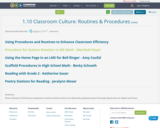
Rubric Element 1.10 Teachers implement routines and procedures for efficiently guiding students through digital and non-digital work time.
- Subject:
- Education
- Material Type:
- Primary Source
- Date Added:
- 07/20/2018

Rubric Element 1.10 Teachers implement routines and procedures for efficiently guiding students through digital and non-digital work time.
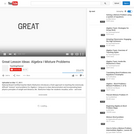
National Board Certified teacher Marlo Warburton introduces a fresh approach to teaching the notoriously difficult "mixture" word problems for Algebra I. Using an in-class demonstration and incorporating basic physics principles of weight and distance, Ms. Warburton helps her students visualize, solve -- and even enjoy! -- these challenging problems.
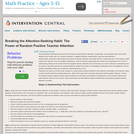
Some students misbehave because they are trying to attract teacher attention. Surprisingly, many students who value adult attention don't really care if it is positive (praise) or negative attention (reprimands)--they just want attention!
Unfortunately, instructors with students who thrive on teacher attention can easily fall into a 'reprimand trap.' The scenario might unfold much like this: First, the student misbehaves. Then the teacher approaches the student and reprimands him or her for misbehaving. Because the student finds the negative teacher attention to be reinforcing, he or she continues to misbehave-and the teacher naturally responds by reprimanding the student more often! An escalating, predictable cycle is established, with the student repeatedly acting-out and teacher reprimanding him or her.
Teachers can break out of this cycle, though, by using 'random positive attention' with students. Essentially, the instructor starts to ignore student attention-seeking behaviors, while at the same time 'randomly' giving the student positive attention. That is, the student receives regular positive teacher attention but at times unconnected to misbehavior. So the student still gets the adult attention that he or she craves. More importantly, the link between student misbehavior and resulting negative teacher attention is broken.
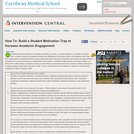
Motivating a reluctant student to complete schoolwork is not easy. In a typical classroom, students can choose from a number of sources of potential reinforcement (Billington & DiTommaso, 2003)--and academic tasks often take a back seat to competing behaviors such as talking with peers. One way that teachers can increase the attractiveness of schoolwork is by structuring lessons or assignments around topics or activities of high interest to the student (Miller et al., 2003).In fact, with planning, the teacher can set up a 'trap' that uses motivating elements to capture a student's attention to complete academic tasks (Alber & Heward, 1996). Here is a 6-step blue-print for building an academic 'motivation trap' (adapted from Alber & Heward, 1996).
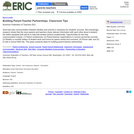
Good two-way communication between families and schools is necessary for students' success. Not surprisingly, research shows that the more parents and teachers share relevant information with each other about a student, the better equipped both will be to help that student achieve academically. Opportunities for two-way communication include: (1) Parent conferences; (2) Parent-teacher organizations or school community councils; (3) Weekly or monthly folders of student work sent home for parent review and comment; (4) Phone calls; and (5) E-mail or school Web site. This paper presents ideas for building parent-teacher partnerships.
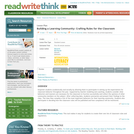
Students will learn to mind their ps and qs in this lesson on etiquette and appropriate behavior in the classroom.
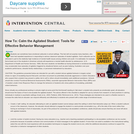
Students can sometimes have emotional outbursts in school settings. This fact will not surprise many teachers, who have had repeated experience in responding to serious classroom episodes of student agitation. Such outbursts can be attributed in part to the relatively high incidence of mental health issues among children and youth. It is estimated, for example, that at least one in five students in American schools will experience a mental health disorder by adolescence (U.S. Department of Health and Human Services, 1999). But even students not identified as having behavioral or emotional disorders may occasionally have episodes of agitation triggered by situational factors such as peer bullying, frustration over poor academic performance, stressful family relationships, or perceived mistreatment by educators.
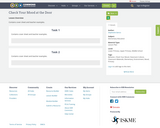
Contains cover sheet and teacher examples.
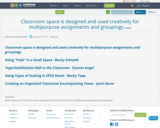
Rubric Element 1.9
Classroom space is designed and used creatively for multipurpose assignments and groupings.
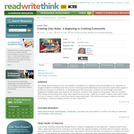
Students work together to create classroom rules by brainstorming why they are at school and what they need while they are there.
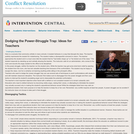
he teacher's most important objective when faced with a defiant or non-compliant student is to remain outwardly calm. Educators who react to defiant behavior by becoming visibly angry, raising their voices, or attempting to intimidate the student may actually succeed only in making the student's oppositional behavior worse! While the strategies listed here may calm an oppositional student, their main purpose is to help the teacher to keep his or her cool. Remember: any conflict requires at least two people. A power struggle can be avoided if the instructor does not choose to take part in that struggle.

As classroom managers, teachers regularly use commands to direct students to start and stop activities. Instructors find commands to be a crucial tool for classroom management, serving as instructional signals that help students to conform to the teacher's expectations for appropriate behaviors.
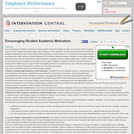
One of the greatest frustrations mentioned by many teachers is that their students are often not motivated to learn. Teachers quickly come to recognize the warning signs of poor motivation in their classroom: students put little effort into homework and classwork assignments, slump in their seats and fail to participate in class discussion, or even become confrontational toward the teacher when asked about an overdue assignment. One common method for building motivation is to tie student academic performance and classroom participation to specific rewards or privileges. Critics of reward systems note, however, that they can be expensive and cumbersome to administer and may lead the student to engage in academics only when there is an outside 'payoff.' While there is no magic formula for motivating students, the creative teacher can sometimes encourage student investment in learning in ways that do not require use of formal reward systems.
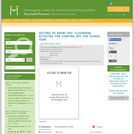
These activities will help you get the year off to a good start by engaging you and your students in getting to know each other, practicing listening skills, and discussing the values that will shape your classroom community. There are separate sets of activities for grades Pre-K to 2, grades 3 to 5, and grades 6 to 12. They are adapted from exercises in our Resolving Conflict Creatively Program and our 4Rs Program (Reading, Writing, Respect & Resolution).

The Good Behavior Game is an approach to the management of classrooms behaviors that rewards children for displaying appropriate on-task behaviors during instructional times. The class is divided into two teams and a point is given to a team for any inappropriate behavior displayed by one of its members. The team with the fewest number of points at the Game's conclusion each day wins a group reward. If both teams keep their points below a preset level, then both teams share in the reward. The program was first tested in 1969; several research articles have confirmed that the Game is an effective means of increasing the rate of on-task behaviors while reducing disruptions in the classroom (Barrish, Saunders, & Wolf, 1969; Harris & Sherman, 1973; Medland & Stachnik, 1972).
The process of introducing the Good Behavior Game into a classroom is a relatively simple procedure. There are five steps involved in putting the Game into practice.

Teachers skilled in classroom management are able to respond appropriately to just about any behavior that a student brings through the classroom door. While having a toolkit of specific behavioral strategies is important, the real secret of educators who maintain smoothly running classrooms with minimal behavioral disruptions is that they are able to view problem student behaviors through the lens of these seven 'big ideas' in behavior management.
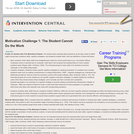
Profile of a Student with This Motivation Problem: The student lacks essential skills required to do the task. Areas of deficit might include basic academic skills, cognitive strategies, and academic-enabler skills. Here are teacher behaviors to help fix this motivation problem.

Although the student has the required skills to complete the assigned work, he or she perceives the ‘effort’ needed to do so to be so great that the student loses motivation. Learn teacher behaviors to fix this motivation problem.
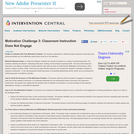
The student is distracted or off-task because classroom instruction and learning activities are not sufficiently reinforcing to hold his or her attention. Learn teacher behaviors to help fix this motivation problem.
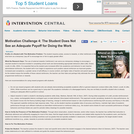
The student requires praise, access to rewards, or other reinforcers in the short term as a temporary ‘pay-off’ to encourage her or him to apply greater effort. Learn teacher behaviors to help fix this student motivation problem.